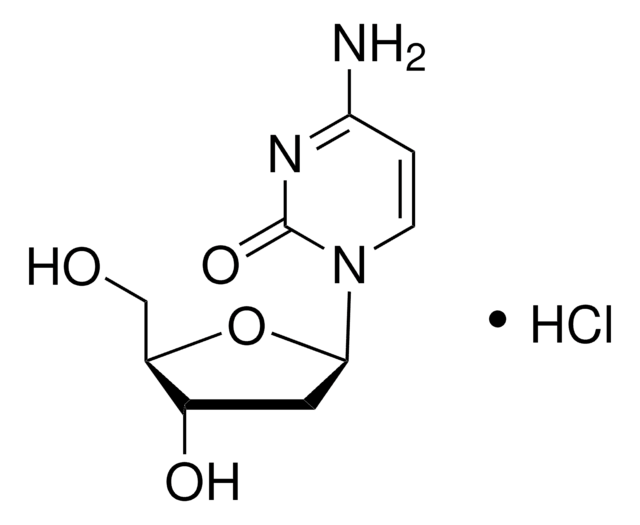C2997
Cytosporone B
≥98% (HPLC), powder, nuclear receptor Nur77 agonist
Sinónimos:
3,5-Dihydroxy-2-(1-oxooctyl)benzeneacetic acid ethyl ester, Csn-B, Csn-B; 3,5-Dihydroxy-2-(1-oxooctyl)-benzeneacetic acid, ethyl ester
About This Item
Productos recomendados
Nombre del producto
Cytosporone B, ≥98% (HPLC)
Quality Level
assay
≥98% (HPLC)
form
powder
color
white to off-white
solubility
DMSO: >20 mg/mL
storage temp.
−20°C
SMILES string
CCCCCCCC(=O)c1c(O)cc(O)cc1CC(=O)OCC
InChI
1S/C18H26O5/c1-3-5-6-7-8-9-15(20)18-13(11-17(22)23-4-2)10-14(19)12-16(18)21/h10,12,19,21H,3-9,11H2,1-2H3
InChI key
UVVWQQKSNZLUQA-UHFFFAOYSA-N
Application
- as a positive control and NR4A1 agonist in NR4A1 reporter gene assay
- for Nr4a1 activation
- to treat OVX mice and study its effect on migration of osteoclast precursor
Biochem/physiol Actions
Nur77 is a nuclear receptor/transcription factor. A physiological ligand for Nur77 is as yet unknown, but there is increasing interest in Nur77 because of its known activities. Translocation of Nur77 from the nucleus to mitochondria initiates cell apoptosis, making it a potential target for cancer treatment. Nur77 is also involved in glucose homeostasis; it induces genes involved in gluconeogenesis. Csn-B physically binds to Nur77 and activates its transactivational activity and translocation to mitochondria to induce apoptosis. It inhibits cancer cell proliferation and tumor growth.
Nur77 is a nuclear receptor/transcription factor with no known physiological ligand, but there is increasing interest in Nur77 because of its known activities. Translocation of Nur77 from the nucleus to mitochondria initiates apoptosis, making it a potential target for cancer chemotherapy. Nur77 also induces genes involved in gluconeogenesis. Csn-B activates the Nur77 translocation to mitochondria to induce apoptosis, inhibiting cancer cell proliferation and tumor growth.
signalword
Warning
hcodes
Hazard Classifications
Acute Tox. 4 Oral
Storage Class
11 - Combustible Solids
wgk_germany
WGK 3
flash_point_f
Not applicable
flash_point_c
Not applicable
Elija entre una de las versiones más recientes:
¿Ya tiene este producto?
Encuentre la documentación para los productos que ha comprado recientemente en la Biblioteca de documentos.
Nuestro equipo de científicos tiene experiencia en todas las áreas de investigación: Ciencias de la vida, Ciencia de los materiales, Síntesis química, Cromatografía, Analítica y muchas otras.
Póngase en contacto con el Servicio técnico









